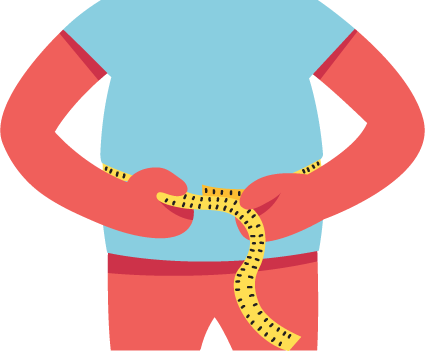Why measuring up is a healthy move
Putting on a few pounds is all too easily done. In fact, almost two thirds of all adults in Northern Ireland are officially overweight or obese - that’s usually down to a mix of poor diet, too much alcohol and not enough physical activity. This can lead to serious health problems such as some cancers, heart disease and type 2 diabetes. Having a bigger waist size increases the risk of developing these conditions. So it’s important to measure up and see what your waistline is.
A waist circumference bigger than those listed below puts you at greater risk of ill health.
Most men: 94cm(37ins) or more
Asian men: 90cm (35ins) or more
All women: 80cm (31.5ins) or more
Similarly, European women are described as being at high risk of developing these serious illnesses when they have a waist measurement of about 35 inches or more, and for Asian women when their waist measurement is about 32 inches or more.
Watch our simple self-measurement guide.
How to measure your waist size
To work out if you are overweight or obese and at increased risk of developing health problems, you need to measure up. As well as checking your weight and body mass index, it's also really important to measure your waist size.
Here's how to do it in five simple steps:
- get hold of a standard tape measure;
- find the top of your hip bone and the bottom of your ribs;
- place the tape measure midway between these points;
- stand up straight and breathe out naturally;
- keep the tape measure snug but not tight around your waist, and write down the result.
Watch our simple self-measurement video guide
Reading the results

- A waist size of 37 inches or more indicates that you have an increased risk of health problems.
- A waist size of about 40 inches or more indicates that you have a high risk of health problems.
- For Asian men, a waist size of about 35 inches or more indicates that you have a high risk of health problems.
![]()
- A waist size of about 32 inches or more indicates that you have an increased risk of health problems.
- A waist size of about 35 inches or more indicates that you have a high risk of health problems.
- For Asian women, a waist size of about 32 inches or more indicates that you have a high risk of health problems.
Working out your body mass index (BMI)
Your body mass index or BMI is calculated using your weight and height measurements, as people’s ideal weight varies according to how tall they are.
Using a simple online BMI calculator can tell you whether you are underweight, overweight or around the right weight for your height.
If you would prefer to calculate your BMI using metres and centimetres, you can use the NHS calculator here.
Calculate your BMI now
You can also check your height and weight against the chart above to find out if you health is at risk.
Remember, just as being overweight is not healthy, being underweight can increase your risk of some health conditions, such as osteoporosis and infertility. If you are underweight, the first step is to visit your GP for help and advice.
The big three: major health conditions caused by obesity
Three of the main health problems caused by obesity – and the lifestyle factors associated with it - are cancer, heart disease and type 2 diabetes. Here’s a little more on those problems and how to protect against them.
Cancer
Cancer is a condition where cells in a specific part of the body grow and reproduce uncontrollably. The cancerous cells can invade and destroy the surrounding healthy tissue – including major organs. Sadly, cancer is still one of the main causes of death in Northern Ireland; yet many of those deaths are actually preventable.
Read More
Heart disease
The heart is effectively your body’s pump. It keeps blood moving round the body through arteries and veins to deliver the oxygen and nutrients needed to help your body function. Sometimes however, the arteries narrow and when this happens to the arteries of the heart, they can get blocked up, leading to heart disease.
Read more
Diabetes
Diabetes is the name for a condition that occurs when the body can’t produce any or enough insulin (a type of hormone) to control the amount of sugar being carried in the blood. There are two main types of diabetes – type 1 and type 2, with type 2 the most common. In many cases, that’s a result of being overweight or obese.
Read more
Measuring Up
It’s easy to put on pounds throughout life, as our TV ad shows. But that can lead to serious health problems that affect your quality of life. Take a look to find out more.
Healthier Choices
If your waistline’s been creeping up on you it can lead to health problems as these TV ads show.
If you think you could be inching towards bad health then download our special information leaflet, which is packed with tips and advice to help you keep your weight and waistline healthy.


